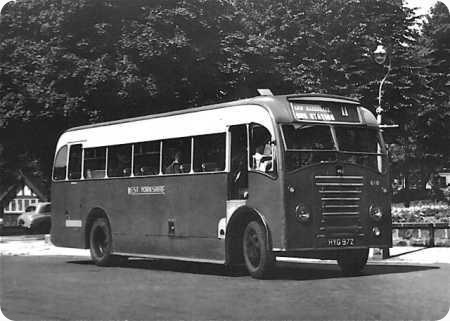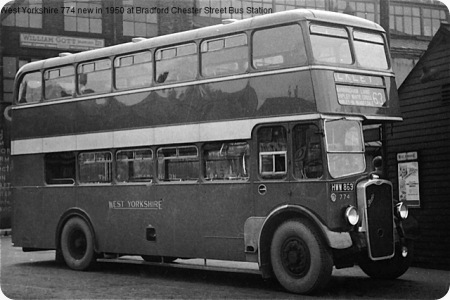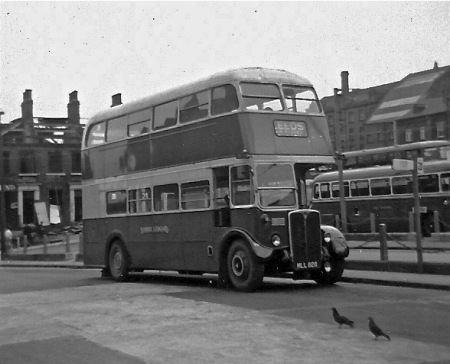West Yorkshire – Morris Commercial – HYG 972 – 618

Photograph by ‘unknown’ if you took this photo please go to the copyright page.
West Yorkshire Road Car Company
1949
Morris Commercial
Beadle B35R
618 was one of a pair (with 619) of Morris Commercial/Beadle buses bought by West Yorkshire in 1949. They were equipped with new Morris Commercial running units and a Morris-built Saurer 6 cylinder diesel engine. I believe Beadle produced this chassisless design for the BTC Group ex Tilling Companies with the intention of using re-conditioned parts. Crosville bought 22 Beadle chassisless buses with re-conditioned Leyland Cub parts and there maybe other operators with similar buses but I am not of aware of any other new-build Morris Commercial/Beadles like West Yorkshire 618/619 with other ex Tilling Companies.
618 and 619 never strayed from Harrogate and always seemed to operate on the local services in the town. Both buses had short operational service lives and lasted only until July 1956. Maybe these two buses were regarded as experimental by West Yorkshire which may explain their short time in service.
They were both then converted into depot service vans which extended their time with West Yorkshire for a year or two but both had been disposed of by 1959.
Photograph and Copy contributed by Richard Fieldhouse
18/03/12 – 15:20
Beadle actually built a single batch of 12 Morris/Saurer integrals for BTC Companies in 1949 with build numbers JCB82-94.
They were:
LTA 148/149 – Western National 2019/20.
MHU 246/247 – Bristol Tramways 2500/1.
HYG 972/973 – West Yorkshire RCC 618/619.
MHN 601/602 – United Automobile CBM 1/2.
FBD 915/916 – United Counties 115/6.
JRU 62/63 – Hants & Dorset TS 846/7.
John Stringer
19/03/12 – 09:13
The United Auto pair (later renumbered M1/2) were even shorter-lived than the WYRCC ones. Retired by UAS in 1955 they went to Bryn Melyn Motor Services of Llangollen which retired them in 1959 – it appears that they were then scrapped. Similar Beadle monstrosities with Bedford running units had equally short life spans and one can only presume that they were cheap!
Neville Mercer
19/03/12 – 09:14
What fascinating vehicles the Beadle-Morris integral buses were. Interesting how the batch was split into pairs for six operating companies John, and one wonders whether they may have been BTC trial vehicles perhaps. The West Yorkshire ones were renumbered SM1/2 (Single-deck, Morris engine) in 1954, and one or two of the older fitters referred to them as Morris-Saurers, due to the engines described by Richard. As stated above, West Yorkshire’s examples were converted by the company into rather neat- looking depot vans, becoming 1023/4 in the service vehicles fleet. (SM2 was converted in 1957, and SM1 in 1959, although both were withdrawn from passenger service as Richard says, in 1956). Each had hinged panels fitted partway along the roof, from the top of the rear doors forwards. This allowed heavier items to be loaded or unloaded using an overhead crane or an ‘iron man’ portable winch. Each vehicle was also shortened from a point behind the rear axle, and their side windows were panelled over. They were painted Tilling green with gold fleet names for their new role, and looked quite attractive conversions.
Brendan Smith
19/03/12 – 14:13
I would be interested to know more about the two operated by Bristol Nos 2500/2501. The registration numbers are from 1949 when I was still in a pram but I cannot recall ever seeing or hearing anything of them. Does anyone have any pictures or idea where they were used and sold/scrapped? They don’t exactly look like things of beauty!
Richard Leaman
19/03/12 – 15:30
Quite interesting that the Ex Tilling companies specified Beadle chassisless units as service buses, whereas the BET used Beadle for batches of coach bodies during these years, using reclaimed pre war running units.
I believe that some BTC companies also received integral Beadle service buses using reclaimed units, the Crosville examples coming to mind, with Pre-war Leyland Cub units.
Another fascinating exercise was that at Eastern Counties, where Dennis Ace units were used in ECW single deck bodies in a similar "chassisless" enterprise.
Quite an interesting subject to look back on, and well worth opening up to wider discussion!
John Whitaker
19/03/12 – 17:34
Does anybody know of any pictures of the two WYRCC examples after conversion to depot service vans.
Eric
19/03/12 – 17:37
The Bristol Tramways pair didn’t last long either, being sold to a dealer in November 1958 and later passing to a showman.
Michael Wadman
20/03/12 – 15:57
Another fascinating posting from Richard F. Thanks very much, Richard.
As my friend John W points out, this is a most interesting topic that raises a whole range of issues. As John W also points out, for instance, Beadle were involved in the early 1950’s with all three South-eastern BET companies, who had quite a lot of semi-chassisless or integral vehicles, with Leyland, AEC and Commer mechanicals. These, as far as the Leyland and AEC running gear was concerned, were largely constructed re-using pre-war parts. (M&D also experimented with integral vehicles by Harrington/Commer, and even a single Saunders-Roe vehicle, fitted, I think, with a Gardner 5LW engine).
However, all these vehicles, whether buses or coaches, were intended for standard operations rather than for lighter duties like the Morris Commercials. I wonder how such an apparently unlikely combination of Nuffield, Beadle and the BTC came about. After all, Morris were hardly mainstream PSV manufacturers, and why was a Saurer engine chosen over other, well-known alternatives?
The ‘wider discussion’ John W calls for might also include the not altogether successful history of light-weight vehicles in general. WY and many other large operators had a few Bedford OBs, which were also quite common amongst independents, but with the possible exception of the Bristol SC, the production of a good light-weight PSV seems to escaped most manufacturers. In my day, there was the unlamented Albion Nimbus, and I guess most of us can remember awful Ford Transit or Mercedes-Benz van-based vehicles, (post OBP period, thankfully!). The prevailing view I remember, however, was the seeming attractiveness of lower initial price and running costs were always going to be outweighed by shorter vehicle life and less dependable service, as well as lack of appeal to passengers. As a senior M&D manager once said to me, ‘Light weights aren’t worth a candle. We should stick to having the right tools for the job!’
Roy Burke
20/03/12 – 17:18
Agree with the M & D manager wholeheartedly but the Albion Victor VTL21 (with Leyland 0.375 engine) was, rather like the Gilford in recent threads, very highly regarded by those who took a chance and bought one. [They were really Leyland’s own answer to the Bedford SB13 – which had the same engine. Significantly, for what they were (light-weight) all Leyland powered Bedfords were at least rated well, if not highly.] The Albion Victor suffered, like the Bridgemaster and FRM1 from being introduced onto the market after newer, more popular designs had cornered the market. It was also more expensive than an SB13!
As for the Morrises….. They had limited prewar success with the Viceroy and Dictator but then withdrew in the face of competition from the big boys. They tried again with an OB sized vehicle after the war, but no-one toppled the OB. Morris had a long and honourable tradition but by 1950 had very old-fashioned engines. Thus when they merged with Austin to form BMC, they also acquired Austin engines and gearboxes which were more up to date and, frankly, better. There wasn’t anything suitable in the cupboard for commercials, so Morris used a Saurer engine built under licence – so strictly it was their own. [Shades of Crossley – sic.]
David Oldfield
21/03/12 – 07:34
The Morris Commercial diesel engines were licensed built Saurer designs that came in 3.4 litre 4 cylinder and 5.1 litre 6 cylinder versions. These engines later had their capacities increased to 3.8 litre and 5.7 litre respectively, and continued in production under Leyland ownership, when they were called the 4/98 and 6/98 – the "98" was the bore measurement in mm, and the stroke was 125 mm.
Saurer pioneered a version of the toroidal piston cavity, sometimes used in conjunction with a four valve head. Other engine makers using the Saurer principles were required to pay royalties, which Crossley, for one, refused to do, with catastrophic consequences for that Company.
The pre-war Morris Commercial bus models had imposing names such as Viceroy, Dictator, Imperial and Director, and some, at least, were designed by AEC’s former Chief Designer Charles K. Edwards, but they did not earn a good reputation and soon vanished from the scene.
Apparently, one of the early Beadle chassisless buses was fitted with Dennis Ace running units and went to Eastern Counties. Perhaps this vehicle was the inspiration for the 16 ECW/Dennis chassisless buses of 1950 that used Ace components.
Roger Cox
21/03/12 – 11:50
Fascinating responses from Roy and others on the "chassisless" debate, which seemed to be "raging" 1949/50 ish. and especially the strategic differences between BTC and BET, with all sorts of side players such as Sentinel.
I know Bristol/ECW had a captive market, but the ensuing chassisless LS was perhaps strongly influenced by this activity, and it was far more successful than the Leyland and AEC variants, even though later replaced by a "Chassis" MW version.
Most of the rural bus operators probably needed lightweight vehicles for sparse and unremunerative routes, and hence the "WYRC "Flying Pigs" and their post war replacements in the form of Beadle OBs , but it would seem that Bristol were intent on using the lighter weight of this concept as a way forward with fuel efficiency for full size vehicles. Just how successful this sort of approach was is not for me to say, as my bus operating experience is "nil".
Was the success of the LS due mainly to its lack of competition, or was it truly a bus operator`s dream?
John Whitaker
22/03/12 – 08:11
Eric, there is a photograph of the pair of West Yorkshire depot vans in a book by Colin Wright – ‘Bus Company Service Vehicles’ (Trucks in Britain Vol 4). I had not realised just how much shorter WY had made them during their conversion until I had hunted out the book again. Looking at the picture of the vans, there are only two bays within the wheelbase, instead of the four present when in bus form. Their integral construction no doubt made the removal of the various unwanted parts easier than on a chassised vehicle. They were fascinating vehicles, but it has to be said that the Beadle bodies did look quite quaint – the styling being somewhat at odds with the technological image associated with integral construction at the time.
Brendan Smith
22/03/12 – 13:31
Thanks Brendan for the information and description. I’ll keep a lookout for that book at events this summer.
Eric
22/03/12 – 13:32
Quaint is not the word I would have chosen for their bodies, Brendan: the kindest I could be would be eccentric!
Its fascinating the way there are hints of ECW with the cream/white strip above the windows.
Chris Hebbron
25/03/12 – 08:58
The comments on lightweight buses stirred some memories. West Yorkshire Road Car took delivery of four ECW-bodied Bedford VAM14 service buses in 1967 (SML 1-4: Single-deck, one Man operation, Leyland engine). They were part of a THC order for twenty (Western National and Eastern Counties were the other recipients) and were meant to be a stop gap measure pending the Bristol LH going into production in 1968. The VAM appeared to be a well-respected lightweight chassis, being popular with many small to medium-sized operators in the independent (especially coaching) sector. Sadly however, the four WY examples lasted barely four years in the fleet. Apparently, they went through quite a few clutches and prop shafts in that time, and they were not too popular with drivers. The Leyland 0.400 engines proved reliable however, and the buses were simple to maintain and repair, but fitters at Grove Park depot (home to two of the VAMs) felt they were just ‘too lightweight’ for their intended duties. Much as Roy, David and the M&D manager would probably concur.
Brendan Smith
14/09/12 – 07:12
The two mentioned JRU 63 and JRU 62 ended up at Aston Coaches Marton in February 1963 and were operated in the PSV fleet for a short time then sold to French Collett Cumnor, Astons also has a number of Leyland Beadles EFU 855/841/842
David Aston
 Vehicle reminder shot for this posting
Vehicle reminder shot for this posting
19/07/14 – 08:07
Over two years ago this thread discussed Beadle chassisless buses with Morris running units. Neville Mercer wrote:-
"The United Auto pair (later renumbered M1/2) were even shorter-lived than the WYRCC ones. Retired by UAS in 1955 they went to Bryn Melyn Motor Services of Llangollen which retired them in 1959 – it appears that they were then scrapped. Similar Beadle monstrosities with Bedford running units had equally short life spans and one can only presume that they were cheap!"
Two points arise.
1. is there any possibility that the bodies of the Llangollen pair were those shipped to Macau – with or without chassis?
2. The Bedford OB/Beadle chassisless, ex-ENOC which went to Macau lasted in arduous service until 1974/75.
In both cases reference to my book (DTS Publishing) gives details.
Mike Davis
Quick links to the - Comments Page - Contact Page - Home Page



